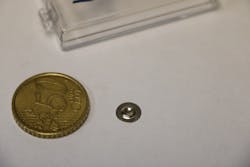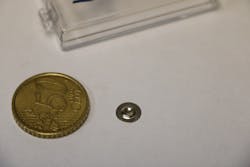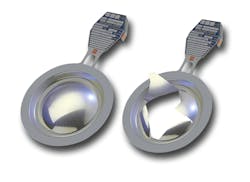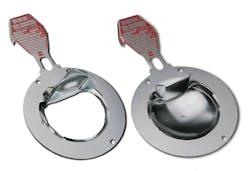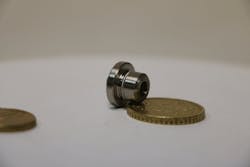Rupture Disks Shrink to Meet Industry Demands
For more than 85 years, rupture disks have been economical and effective as passive safety mechanisms for protecting tanks and other enclosed vessels against overpressures and potentially damaging vacuums. However, to meet the demands of a new generation of smaller, lighter applications, disk manufacturers had to come up with new designs and materials to overcome several engineering challenges.
Fortunately, leading rupture disk manufacturers were up to the tasks and were able to come up with novel structures, advanced materials, and design elements that let disks as small as 1/8th of an inch handle pressures ranging from low (15 to 1,000 psi) to medium (350 to 16,000 psi) to high (1,500 to 70,000 psi).
Rupture Disk Basics
Rupture disks (also known as bursting disks) and relief valves are the two most common pressure-relief devices. Rupture disks burst and activate within milliseconds after a differential pressure, either positive or vacuum, reaches a predetermined level. They rely on a one-time-use membrane usually made out of various metals, though exotic alloys and graphite are also used. The disk must be replaced after it is activated; these are one-time use devices.
Relief valves also open when a specific level of pressure or vacuum is reached, but they reset once the pressure returns to a safe level. Some relief valves reseat themselves and are re-used. Others—mainly those with small, threaded connections—pop open accurately once and then crudely reclose, but not with the original level leak tightness.
In many applications, engineers prefer the superior leak tightness and flow characteristics of rupture disks over pressure relief valves, which are known to leak. Rupture disks also have flow areas and, hence, flow capacities in line with their nominal connection size. Valves, on the other hand, have flow area and capacities routinely smaller than their nominal connection size. This is because relief valves have a host of components that need to be accommodated and they obstruct the flow path. In general, a rupture disk of the same nominal size as a relief valve will let 2 to 8 times the amount of gas or liquid escape in the same amount of time.
Because overpressures and vacuums are so potentially damaging, many engineers incorporate a relief valve and a rupture disk, with the disk positioned between the pressurized fluid and the valve. The disk prevents leaks and buildup of process materials that might get stuck to the valve, preventing it from operating, or else corroding and damaging the valve.
Rupture disks have also been used as one-time fast acting valves or triggering devices to reliably and quickly initiate a sequence of actions. For example, miniature rupture disks in vehicle air bags seal off small cylinders filled with pressurized gas. The disks are blasted open by a pyrotechnic device triggered when sensors identify a vehicle collision. In the oil industry, rupture disks are used in a downhole tool as a fluid seal that is also pyrotechnically actuated. When the disk is burst, it lets fluid flow through a drill pipe at the desired location deep underground.
Going Small
For decades, rupture disks usually ranged in size from 1 to 6 in. and were used in a wide variety of applications: petrochemical, aerospace, defense, medical, railroad, nuclear, chemical, pharmaceutical, food processing, and oil field. When needed for larger piping applications, the disks can be as large as 60 in. nominal size. To install the disks, they are held in place with a device called a safety head and mounted between flanged pipe ends (see image below). The safety head seals the rupture disk into the piping system with its required dimensions and seating arrangement, thereby getting the best performance from it.
However, manufacturers making parts and assemblies for vehicles and other transportation equipment have increased their focus on making vehicles lighter to conserve fuel. This means they want smaller, lighter rupture disks, increasing the demand for disks well under 1 in. in diameter.
Disks have traditionally used a forward-acting design in which loads are applied to the concave side of the dome. The thickness of the dome material and diameter of the fitting in which it is mounted determine performance. However, in this approach the rupture disk is prone to metal fatigue that results if there is aggressive pressure cycling and operating conditions, and these can shorten the disk’s operational life. To compensate for this, forward-acting disks have been limited to applications having operating-to-burst pressure ratios of 75% or less to avoid fatigue, which can lead to unwanted activation.
Exacerbating the issue, forward-acting miniaturized disks with low set pressures use tissue-paper-thin domes that are fragile and prone to leaking when assembled. In a reverse buckling design, on the other hand, the dome is inverted toward the source of the load.
The burst pressure of forward-acting rupture disks is a function of the dome material’s tensile strength, thickness, temper, diameter, and control features (such as a score line on the dome). The burst pressure of a reverse buckling rupture disk is also a function of the material tensile strength, thickness, temper, and diameter, as well as the dome material’s modulus of elasticity and the shape of the dome. The domes in reverse- and forward-buckling disks can also have control features such as structural apex forming (SAF), an indent made in the apex of the dome. That means designers have more variables to adjust the burst pressure when manufacturing reverse-buckling disks.
By loading the reverse-buckling disk in compression, it is able to resist operating pressures up to 100% of minimum burst pressure even under pressure cycling or pulsating conditions. The result is greater longevity, accuracy, and reliability over time. For all these reasons, designers concentrated on reverse-buckling designs when it came to miniaturized burst disks.
But even reverse-buckling domes are not that easy to make smaller. Decreasing these domes’ diameters makes it difficult to design them to reliably collapse through such small orifice sizes. But engineers eventually learned how to create specially shaped domes that collapse in a predictable manner.
For example, engineers at BS&B created a hybrid dome shape that combines reverse and forward bulging characteristics that are pre-collapsed. In this type of design, mechanical scoring creates a line of weakness that helps control the collapse of the dome and opening of the disk upon activation.
Rupture disk performance is also dictated to some extent by the diameter of the dome: The smaller the area of the dome, the more effect the dome’s diameter has. In fact, with smaller disks, the influence of every feature of both the rupture disk and its holder is amplified. This means that normal manufacturing variations of machined supports for the dome can throw off the accuracy of the dome’s prescribed burst pressure. BS&B uses a proprietary design and manufacturing method to maintain burst-pressure accuracy of the smaller domes.
However, we can say that for rupture disks between 0.25 and 1 in. in diameter certified for burst pressures up to 70,000 psi, BS&B manufactures them and the holder from a single piece of Hastelloy, Inconel, or carbon steel. This eliminates the usual connections between the dome and its support fitting. It also makes the rupture disk is intrinsically leak-tight by virtue of their unitary construction.
The miniature rupture disks are typically threaded for installation, but configurations are available for welding, soldering, or crimping based on the application conditions and leak tightness requirements. This includes “sealed for life” applications such as refrigeration systems, air-bag inflators, fire protection equipment, and aircraft safety devices that require exacting reliability, and which owners do not want to recharge repeatedly.
Looking for parts? Go to SourceESB.
